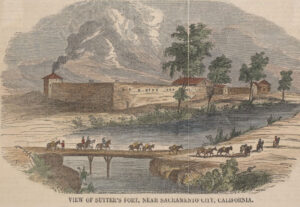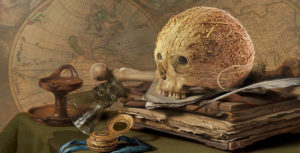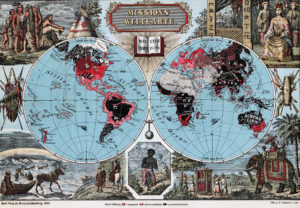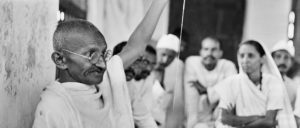
© Walter Bosshard / Fotostiftung Schweiz / Archives of Contemporary History, ETH Zurich
Gandhi in a new light
The photographs of the Mahatma taken by Swiss photographer Walter Bosshard were seen around the globe.
Walter Bosshard, who grew up in a small farming village on Lake Zurich, was originally a teacher and was studying art history when the First World War broke out and led him in a completely different direction. Shortly after the end of the war, he drifted to Asia and tried his luck in various jobs: on a plantation, as a gem dealer, and as technical director of a scientific expedition. Around 1928/29 he returned to Europe, and saw his chance in the booming photojournalism industry. Anyone with a good eye for exciting pictures and suspenseful stories, who also had some street smarts and a thirst for adventure, could quickly achieve success and fame. Even then, Bosshard was considered an Asia expert. And in 1930 he was offered a fantastic assignment: the Münchner Illustrierte Presse, a German periodical, commissioned him to spend eight months travelling around India reporting on the independence movement.
On 21 February, the Swiss reporter arrived in the port of Bombay. From there, he travelled the length and breadth of India by car and rail, covering more than 20,000 kilometres, visiting 10,000 towns and villages, and speaking to more than 5,000 people, as he later wrote in his book Indien kämpft! (India fights!). In addition to reports on the decadence of British colonial rule and life in the villages of India, a face-to-face meeting with the leader of the independence movement was also on his agenda.
On the evening of 11 March, the day before Gandhi set off on the legendary Salt March, the two met for the first time at the Sabarmati Ashram. However, Bosshard only had a short amount of time for a brief interview – he didn’t use his camera at that stage. He asked the Mahatma questions about the controversial salt tax, and coaxed out of him a general assessment of the situation in India. But he was impressed most of all by the imperturbable serenity with which Gandhi kept his spinning wheel whirring ceaselessly throughout their conversation, working his way through a big pile of unspun cotton.
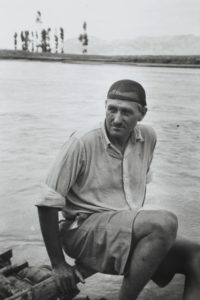
Walter Bosshard on a river journey in China in 1933.
Fotostiftung Schweiz
For his second encounter with the Mahatma, Bosshard travelled to the coast, where the protest march was to end. When he arrived at the headquarters of the independence movement on 7 April, Gandhi was waiting for him surrounded by his inner circle. In this relaxed atmosphere, Bosshard had a whole morning to observe the Mahatma without interruption, asking him questions from time to time, but then stepping back into the shadows and letting the special mood of the moment take over. Although Walter Bosshard carried a cumbersome medium-format camera, for which a new film cassette had to be inserted after each shot, he worked so unobtrusively that as time went by, Gandhi hardly noticed him anymore. And after he had photographed the Mahatma eating, laughing, reading, discussing, lecturing, spinning and shaving, he ventured even further: ‘“May I also take a photo of Gandhi sleeping?” I asked the young man standing at the door. “If you do it quietly, you can try. But don’t wake him, because he needs his rest.”’
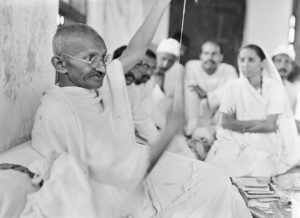
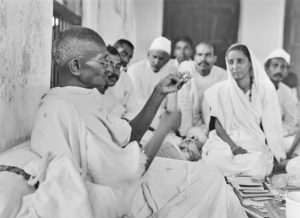
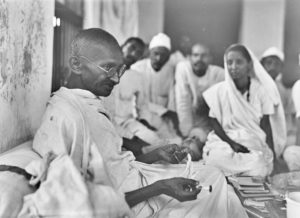
“He (…) eagerly twisted the white cotton thread as if for him there was nothing else in the world but spinning yarn.”, Walter Bosshard, 7.4.1930.
© Walter Bosshard / Fotostiftung Schweiz / Archives of Contemporary History, ETH Zurich
As a result, the global public was treated to the first celebrity ‘behind-the-scenes story’ about one of the most famous men of his time. The Münchner Illustrierte Presse published Bosshard’s feature in its edition of 18 May 1930, and was well aware of the sensation it created. On the front, the magazine had a full-page portrait of the Mahatma reading, but inside it also paid tribute to the photographer. ‘Our representative W. Bosshard is the only European reporter who was welcomed by Gandhi at his encampment on the coast during the illegal salt production campaign’, read the headline under the title ‘Mahatma Gandhi in private!’ printed in bold.
The readership of the Münchner Illustrierte got to see only a very small selection of the work Walter Bosshard had accomplished that morning. Certainly, the five photos showing highly personal scenes and activities that were printed in the magazine were enough to cause a stir. First, people read about Gandhi the powerful political figure, the ‘man who has challenged the British Empire’; then, in Bosshard’s photographs they came face to face with an ordinary and unassuming person who had very everyday wants and, with a philosophical dignity, focused entirely on the essentials. Reading, eating and sleeping are the few, key activities depicted in the photo story that was published. But the gentle light that filters into the enclosed space and breaks up the soft, white folds of Gandhi’s plain cotton robe gives these simple actions a spiritual, even meditative dimension. It is not least this very concentrated, masterfully captured mood that made Bosshard’s pictorial feature stand out from the torrent of daily news reports.
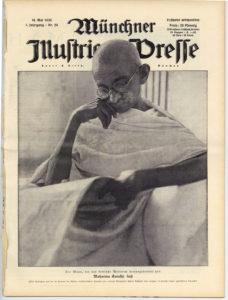
Cover of the Münchner Illustrierte Presse edition of 18 May 1930.
Swiss National Museum

